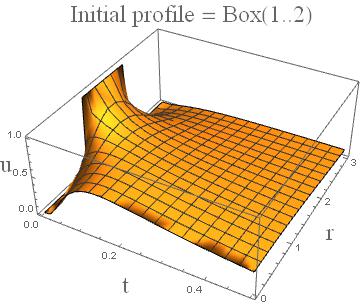Abstract
This problem is close to a standard case of diffusion in cylindrical coordinates but at the same time distinct enough to become interesting in itself. The initial value problem on the half space x>=0 is solved explicitly, where I have used an orthogonality relation for Bessel functions which I didn't find quickly in the literature; so I derived it, making extensive use of MMA. Solution examples are given.
Section 1: The solution
Your equation (assuming $\nu =1$, to begin with) is a fairly conventional linear partial differential equation given by
eq = D[u[r, t], t] == 3/r D[Sqrt[r] D[Sqrt[r] u[r, t], r], r] // Simplify
$$2 u^{(0,1)}(r,t)=\frac{9 u^{(1,0)}(r,t)}{r}+6 u^{(2,0)}(r,t)$$
The separation ansatz
u = Exp[- 3 k^2 t] v[r]
with a separation constant $k$ leads to an equation for $v(r)$ which can be solved easily:
DSolve[6 v''[r] + 9/r v'[r] + 6 k^2 v[r] == 0, v[r], r]
(*
Out[194]= {{v[r] -> (BesselJ[1/4, k r] C[1])/r^(1/4) + (BesselY[1/4, k r] C[2])/r^(
1/4)}}
*)
The expansion of the two particular solutions close to $r=0$ is
Simplify[Series[BesselJ[1/4, k r] /r^(1/4), {r, 0, 2}], {r > 0,
k > 0}] // Normal
(*
Out[207]= k^(1/4)/(2^(1/4) Gamma[5/4]) - (k^(9/4) r^2)/(5 2^(1/4) Gamma[5/4])
*)
Simplify[Series[BesselY[1/4, k r] /r^(1/4), {r, 0, 2}], {r > 0,
k > 0}] // Normal
(*
Out[206]= -((k^(1/4) Gamma[-(1/4)])/(2^(3/4) \[Pi])) - (2^(1/4) Gamma[1/4])/(
k^(1/4) \[Pi] Sqrt[r]) + (2^(1/4) k^(7/4) r^(3/2) Gamma[1/4])/(3 \[Pi])
*)
Hence we need to put C[2] -> 0 to obtain a finite solution at $r=0$.
The general solution of the PDE is therefore
us[x_, t_] :=
Integrate[a[k] Exp[-3 k^2 t] BesselJ[1/4, k r] /r^(1/4), {k, 0, \[Infinity]}]
Where $a(k)$ is an arbitrary function of $k$.
At $t = 0$ we have the initial distribution us[r,0] = u0[r].
u0[r_] := Integrate[a[k] BesselJ[1/4, k r] /r^(1/4), {k, 0, \[Infinity]}]
This formula can be inverted to give the function $a(k)$ as follows: Multiplying u0[r] by r^(5/4) BesselJ[1/4,r q], then integrating over r from 0 to [Infinity] and using the orthgonality relation
$\int_0^{\infty } r J_{\frac{1}{4}}(p r) J_{\frac{1}{4}}(q r) \, dr = 1/q \delta (p-q)$
gives
aa[k_] := k Integrate[u0[r] r^(5/4) BesselJ[1/4, k r], {r, 0, \[Infinity]}]
Section 2: examples
Section 2.1: given initial conditions
----- Initial profile = DiracDelta peak at r = 1
The r integral gives immediately
adelta[k_, R_] = k R^(5/4) BesselJ[1/4, k R];
and the solution is (the exact integral is not performed by MMA)
udelta[r_, t_, R_] :=
NIntegrate[
adelta[k, R] Exp[-3 k^2 t] BesselJ[1/4, k r]/r^(1/4), {k, 0, \[Infinity]}]
Here is the plot
Plot3D[udelta[r, t, 1], {t, 0, 0.2}, {r, 0, 2},
AxesLabel -> {Text[Style["t", Large]], Text[Style["r", Large]],
Text[Style["u", Large]]},
PlotLabel -> Text[Style["Initial profile = DiracDelta(r-1)", Large]],
PlotRange -> All] // Quiet

----- Initial profile = box (= 1 für 1<r<2)
aa1[k_] = k Integrate[ r^(5/4) BesselJ[1/4, k r], {r, 1, 2}]
(* Out[61]= -BesselJ[5/4, k] + 2 2^(1/4) BesselJ[5/4, 2 k] *)
ubox[r_, t_] :=
NIntegrate[
aa1[k] Exp[-3 k^2 t] BesselJ[1/4, k r] /r^(1/4), {k, 0, \[Infinity]}]
Plot3D[ubox[r, t], {t, 0, .5}, {r, 0, 3},
AxesLabel -> {Text[Style["t", Large]], Text[Style["r", Large]],
Text[Style["u", Large]]},
PlotLabel -> Text[Style["Initial profile = Box(1..2)", Large]],
PlotRange -> All] // Quiet

Section 2.2: given functions $a(k)$
----- Example 1: a = 1
us1[x_, t_] =
Integrate[ Exp[-3 k^2 t] BesselJ[1/4, k r] /r^(1/4), {k, 0, \[Infinity]},
Assumptions -> {t > 0, r > 0}]
(*
Out[210]= (E^(-(r^2/(24 t))) Sqrt[\[Pi]] BesselI[1/8, r^2/(24 t)])/(2 Sqrt[3] r^(
1/4) Sqrt[t])
*)
You can look at the plot (not shown here)
Plot3D[us1[r, t], {r, 0, 4}, {t, 0, 1}]
----- Example 2: a[k] = DiracDelta[k-1]
giving
us2[r_, t_] := Exp[-3 t] BesselJ[1/4, r ] /r^(1/4)
Plot3D[us2[r, t], {r, 0, 20}, {t, 0, 1}, PlotRange -> All] (* not shown here *)




